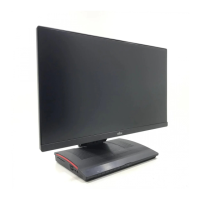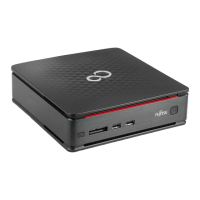PC Specialist's Handbook ErgoPro e-, x- and s- Series
First Edition, Release 4 - June 1998 Page 59
5A Check memory addressability by writing 0010 at 100000, 0020 at 200000 then 0040 at 400000 and so
on until end of memory. The data is then verified in another loop. If all address lines are good then
next checkpoint is 5C.
5B If extended memory size doesn't correspond to CMOS, print error message on screen.
5C Check extended memory data with patterns FFFF, AAAA, 5555, 0101 and 0000. Each 64k block
tested is verified with a message written on screen.
5D Set size of good extended memory in CMOS cells 30 (lsb) and 31 (msb). Switch back to real mode.
(Checkpoints will restart with 00)
60 Make E000:0000 to F000:FFFF cacheable. Enable CPU cache. Copy compression header &
algorithm to RAM.
61 Decompress BIOS.
62 Distribute BIOS.
80 Reset cause = Memory tested. Restore both 8259's interrupt masks.
81 Compare extended memory size against size specified in CMOS cells 17 and 18 and update CMOS if
necessary.
82 Test the real time clock against the 8254 timer by checking that the UIP (Update In Progress) bit is
toggling.
83 Initialize and selftest the keyboard.
84 Enable keyboard interrupts (IRQ 1).
85 If the 'Ins' key is pressed then clear the 'ResetFlag' indicating cold reset and jump to the Resident Set-
up Utility. No more checkpoints will be issued. S458: Set up cache. ead KB ID and set numlock if
requested in CMOS RAM.
86 Search for printer ports attached (the data register is written and then read back) and report their base
addresses in BIOS data area. The 'EquipmentFlag' is updated to reflect the number of printer ports
attached.
87 Search for RS-232 ports much in the same way as above (the Int_ID register is read and tested
against data F8).
88 Set-up floppy drive(s) according to CMOS memory cell 10. The drives are initialized using BIOS
interrupt 13. Modify 'EquipmentFlag' to reflect the number of floppy drives in the system.
89 If CMOS cell 12 is zero then jump to checkpoint 8A. Else, set-up and initialize hard disks according to
CMOS memory cells 12, 19 and 1A. Modify 'EquipmentFlag' to reflect the number of hard disk drives
in the system.
8A For each bit set in the CMOS error cell (0E) an appropriate message is printed on screen.
8B Turn off NMI and clear any parity errors. Option PROMs from C800:0000 to (not including) E000:0000
are checksummed and then installed by a far call to each PROM.
8C The BIOS ResetFlag (at 0040:0072) is cleared.
8D If no errors is reported in the CMOS error cell (0E) or in BIOS data area error byte (0040:0012) then
next checkpoint is 90.
8E Beep twice (frequency = 523Hz = C2), display the 'Press F1 to continue' message and wait for the 'F1'
key. However, if error was a faulty keyboard then ...
8F ... wait (4 seconds) and continue with boot.
90 Beep for 1/2 second at 880 Hz.
91 Adjust the BIOS data timer tick cells (words 0040:006C and 006E) to show the number of ticks since
midnight. (This involves reading the CMOS clock via BIOS interrupt 1A)
92 Detect and initialize the 80287 controller. If nothing is found then next checkpoint is 94.
93 80287 found. Its interrupt is enabled and the 'EquipmentFlag' is updated. If the CMOS memory
'FeatureFlag' is enabled then also the CMOS memory equipment byte is updated.
94 IRQ 9 is enabled
96 Disable NMI and clear any parity error. Any BIOS option PROM at E000:0000 is checksummed and
initialized by a far call to it. Continue with checkpoint A0.
9F Disable interrupts and jump to shadowed BIOS.
